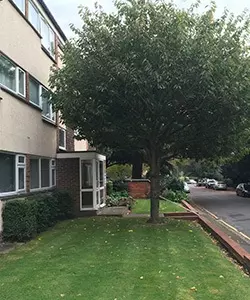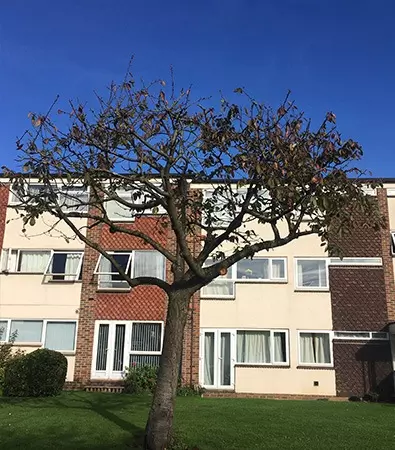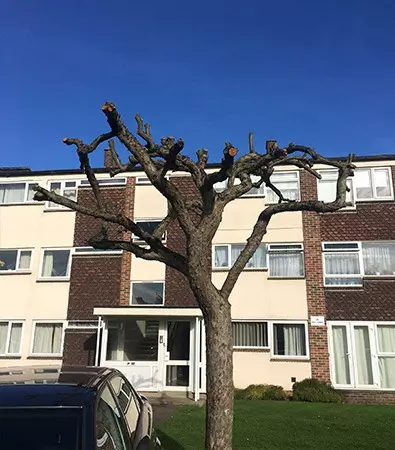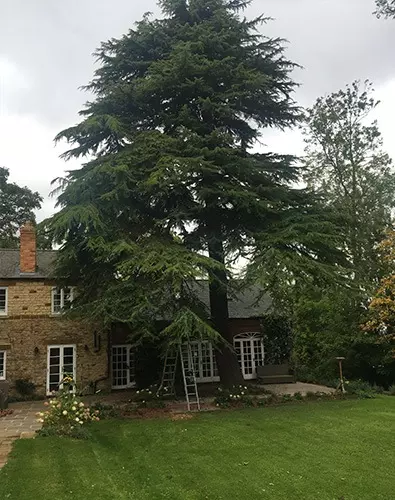Tree Crown Management
Northampton, Milton Keynes, Bedford
Are you looking for tree crown management in Northampton and the surrounding areas? If a tree is structurally sound, crown reduction should not be used for preventing a tree from falling over in a storm.
The preferred method, in this case, is crown thinning. When a tree has its canopy reduced, the cuts made can stress the tree. A thinning cut will cut back to a natural boundary.
What does it mean to crown a tree?
The crown of a tree or shrub consists of the leaves, branches and reproductive structures that extend from the main trunk. Where there is a community of crowns growing in an area, this is known as a canopy or a crown.
Crowning can also be known as crown lifting or crown raising. This is done by removing the lower branches or by preparing these branches for removal at some future time.

How can a crown be reduced?
You can reduce the size of a tree by using shearing, tipping, and rounding techniques. These are methods that do not cause decay by compromising the tree's structure. Cuts should be made to leave the bark on the outer edge intact. After pruning, the cuts should not be evident when you stand back and look at it. .

Before

After
What is topping a tree?
When whole treetops or large branches and trunk is removed from a tree, this is known as tree topping. The result is stubs or branches that are not able to develop as a terminal leader. The process is also commonly known as tipping, heading, rounding over or hat-racking.
When a tree is over-pruned, it can have a negative effect on the tree. This can cause decay in the branches and trunk. If it is required that a tree's height is reduced, it must be carefully considered. A customer will need to understand the impact that topping will have on the health of a tree.
Crown reduction is usually preferred to topping as a safe way to reduce the size of a tree. Another choice is to remove the tree and replace it with a smaller maturing plant.
Main Tree Pruning Definitionsconact
There are many reasons that trees require pruning. This is to help ensure the trees are safe, remove any dead branches, encourage growth, control their size, or promote high-quality fruits or timber. On the other hand, incorrect pruning can lead to a tree becoming ugly, diseased or even hazardous.
You may better understand what your tree surgeons might be recommending, or, in fact, so that you can more accurately ask for the tree services that you would like. Here is a trio of definitions regarding the pruning of tree crowns.
Crown Thinning
The thinning of a crown is the process of removing thinner branches from the outer edges of the crown from trees.
This produces a more rounded, orderly section of greenery around an orderly lattice of branches. This process will not alter the tree's overall look and shape and is usually only carried out on species of trees that produce broad leaves.
The removal of these thinner branches should be done so methodically all around the crown's area to the specified percentage, but not exceeding 30%.
The crown's thinning is commonly carried out to allow more sunlight to reach the interior of the tree's branches.
It may also limit wind resistance and reduce the tree's overall weight. Thinning is a repeat process that must be carried out multiple times throughout a tree's life, especially if it produces epicormic budding.
Crown Reduction
Crown reduction is the process of lowering the height and area that the crown extends to.
Reductions may be carried out to reduce any strain the tree's branches may be under, help the tree to fit into its surroundings, reduce shadowing, and allow more sunlight to reach the crown's interior.
The final look of the crown should look as it did before, only smaller. Symmetry should not be achieved by force, making the tree appear unnatural.
Reductions should be limited as much as possible, generally not exceeding 10cm in diameter. The reduction measurements should be accurately specified, for example, a height reduction of 1 metre and width spread reduction of 2 metres.
There are tree species that are not suitable to undergo reductions, and reductions should not be confused with the more harmful process of 'topping'.
Crown Lift or Crown Raising
Crown lifting or raising is the process of removing the bottom-most branches of the tree crown.
This should not include removing large branches that grow directly from the trunk, leading to further damage to the tree through rotting. If the tree is of a significant age, crown raising should be limited to the thinner exterior branches to avoid considerable damage.
This process is an effective way of allowing sunlight to reach the crown's inner areas, but removal should be limited to under 15% of the overall crown height.
The crown should make up at least 60% of the tree's height once the lifting has been done. There should be clear guidelines as to where the crown should be lifted to, for example, 6 metres above ground level.
The importance of correct pruning cuts
Every time a tree undergoes pruning, it takes damage. The way the pruning cuts are applied to the tree branches significantly affects the tree's ability to recover and regrow.
The size of the cuts and the angle and location regarding the remaining parts of the tree all contribute to the branch's ability to continue growing.
It is generally advised that the branches be removed when they are attached to the remaining part of the tree. Either this or laterally shortened to a diameter that is 33% the size of the removed section of branch.
Any cuts made to the tree branches should be kept as small as possible to limit any damage done to the tree.

Contact us today for Tree Crown Management on 01933 666078. Read more about our full range of tree surgery services in Northampton, Milton Keynes and Bedford.
- Northampton
- Rugby
- Kettering
- Olney
- Daventry
- Brixworth
- Wellingborough
- Bedford
- Market Harborough
- Desborough
- Milton Keynes
- Shanbrook
- Buckingham
- Silverstone
- Towcester
- Roade
